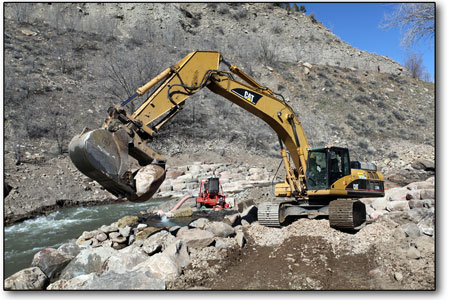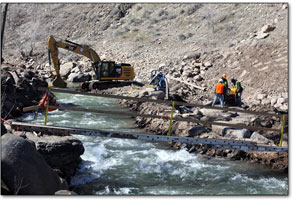 |
|
An excavator moves boulders near the former Corner Pocket rapid last week. With temps on the cool side and the river at a workable 250 cfs this week, crews were in overdrive in advance of the looming goal of an April 15 deadline for in-stream construction./Photo by Steve Eginoire |
Ready to launch
Horizon line in sight as crews toil to finish Whitewater Park
by Missy Votel
After several years of anticipation, countless public meetings, 3,600 tons of free boulders and hundreds of cubic yards of grout, Durango boaters can stop holding their breath. But they can’t get in the water just yet.
Although progress on the City’s $1.3 million Whitewater Park has been exhaustive but steady, an official opening date is still a bit murky. Yes, it will be sometime this spring, but exact timing depends on a number of unpredictable factors, most notably the fickle spring weather. With temps on the cool side and the river at a workable 250 cfs this week, crews were in overdrive in advance of the looming goal of an April 15 deadline for in-stream construction.
“Right now, crews are working around the clock,” said Scott McClain, City of Durango Landscape Architect and planner. “Sometimes, I’ll drive by at 9 or 9:30 at night and see their lights on down at the river, working.”
Contractor Ted Seipel Construction, of Eagle, began work on the Whitewater Park’s four enhanced play features in earnest on Nov. 15. Project managers knew coming in that timing would be close, with contingency plans that any work left unfinished by spring run-off would be completed the following winter. Since then, cold temperatures unconducive to grout pouring and a few mishaps with the excavator – it tipped over twice – have made that deadline even thinner.
“We knew it was tight going in,” said McClain. “We still have a plan, and we think we can make the deadline.”
Park designer Scott Shipley, of Boulder’s S20 Engineering, who was in Durango in February to chart the progress, also was optimistic. “It’s definitely been giving me heartburn, but it’s looking like we’re going to make it.”
|
Work continues near the ‘old’ Smelter Rapid last week. Originally built in the late 1980s, the park was the first of its kind in the U.S., drawing paddlers from far and wide and spawning a generation of Olympic athletes./Photo by Steve Eginoire |
In the meantime, however, the City and crews are asking curious onlookers to stay away or observe the construction from the Dog Park. And just because plans call for having heavy equipment and extra material out of the river by April 15, it does not mean the river will necessarily be open. In-stream work may continue after that date and the adjoining trail and banks are slated for construction this summer. Plans call for a widened bike trail, multiple sitting areas, improved river access and bank stabilization.
As for when the river will be open to the public, that date has yet to be determined.
“The river will remain closed, it will still be a construction site down here,” Dan Woolley, project manager with S20 said. “We’re going to need to keep people at bay just a little longer.”
But when the rope finally drops to river traffic, boaters can expect a whole new river experience. While crews were still working on Smelter Rapid, removing the dreaded Allen’s Pile and center island, for the most part, work on the park’s three other features – Corner Pocket, “Ponderosa” and Clock Tower – were all but finished.
According to Woolley, the new features are being designed with an eye toward a wider range of usability. Using tiered channels that funnel the water at lower flows, he expects play features to come in at flows as low as 600 cfs. As the water comes up, the features will stay relatively the same but grow in size.
“We certainly want a wider wave for more people and a better surfing experience,” he said, adding that some features will offer more dynamic holes for tricks while others will offer smoother, friendlier waves for front surfing.
Woolley said all the features are designed with room to make minor tweaks down the road if need be. “We have a bit of room to make adjustments with the interim features,” he said, referring to the wing outcrops that channel the flows between play features. “It’s a little bit of an art and a science. There’s a lot of intuition and experience that’s involved.”
And while the idea of grouting, or a new park in general, was not always popular among some in the boating community, it is water under the bridge at this point.
As per the city’s 2007 recreational in-channel water diversion right, or RICD – which guarantees flows of at least 1,400 cfs for recreation – there must be permanent structures in place to direct the flow. As a result, grout is used as a longer-term alternative to merely stacking rocks, which can often get blown out during high-water events.
Regardless of views on the use of grout, there is no denying that building whitewater parks is big business. Over the last decade or so, manmade or enhanced parks have sprouted up everywhere from Glenwood to Gunnison, North Carolina to Green River, Wyo., and Reno to London, where S20 built the 2012 Olympics kayak course.
After their work is done in Durango, S20 will move onto building a pumped whitewater course in Oklahoma City, followed by a course in Ketchum, Idaho.
For supporters of the park in Durango, they are hoping it will help bring back the town’s former glory as a mecca of whitewater paddling. Originally built in the late 1980s, Durango’s Whitewater Park was the first of its kind in the country, drawing paddlers from far and wide and spawning a generation of Olympic athletes. State-of-the-art at the time, the park eventually lost some of its luster next to newer, more modern parks that cater to smaller play boats and aerials.
Local paddling icon Nancy Wiley, who has been paddling the Animas River for nearly 40 years, stopped to check out the park’s progress during a recent walk-through with McClain. She said she was impressed to see “the next generation” taking over and looked forward to experiencing the end result.
“I’m excited that we have such an incredible whitewater park and are fortunate to have the Animas River in town,” she said. “I know some people don’t want the river to be changed, but the reality is, the whole river’s been changed. To have an enhanced park that everyone can use is a real treat.”
Local whitewater-focused businesses are hoping the new park will provide a boost as well. “We need it; we need an uplift in whitewater,” said Ashleigh Diaz, a paddler and manager at Four Corners River Sports. She said in the years she’s been kayaking, she’s seen participation in the sport wane, partly due to an increased interest in SUPing.
She hopes the new park will reignite a local interest in kayaking while expanding offerings for SUPing as well. “We’ve been talking about the park for years, I think it’s great to see it come to fruition. We’re hoping this is going to be a boost for kayaking.”
And while buzz over the new park is growing in the local boating eddy, perhaps nowhere is it more palpable than at ground zero, where extremely dexterous excavators build the park, boulder by boulder, day by day.
“It’s all coming together very quickly,” said Woolley. “This is the most exciting part of the process: the end. Pretty soon, people will be able to come down, relax, watch the boaters and enjoy the sunshine.”
In this week's issue...
- January 25, 2024
- Bagging it
State plastic bag ban is in full effect, but enforcement varies
- January 26, 2024
- Paper chase
The Sneer is back – and no we’re not talking about Billy Idol’s comeback tour.
- January 11, 2024
- High and dry
New state climate report projects continued warming, declining streamflows

